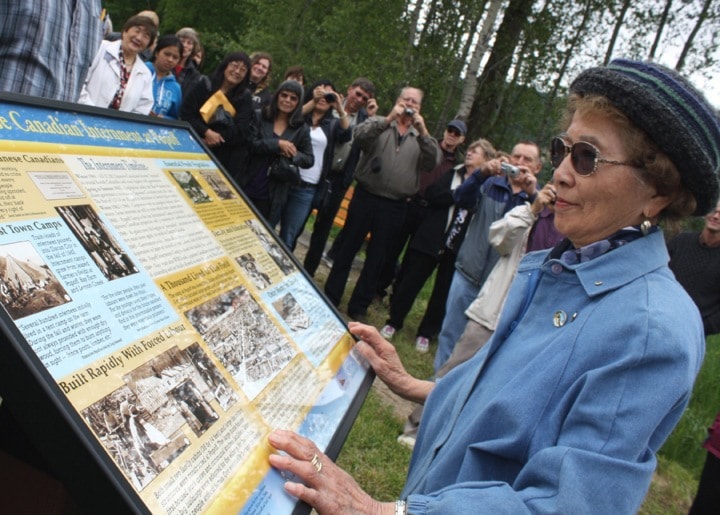SLOCAN — As a writer in the prime minister’s office in the mid-1970s, Joy Kogawa asked the national monuments board about commemorating the sites of former Japanese Canadian internment camps like those in the Slocan Valley.
They replied the government didn’t wish to remember those events.
Though disappointed, “I thought someday it will happen. And here it is.”
On Saturday, Kogawa, whose family was interned at Slocan City, returned to unveil an interpretive sign at Lemon Creek — the first permanent acknowledgement of what occurred there during World War II.
Kogawa, whose acclaimed 1981 novel Obasan is partly set in Slocan, told the large crowd gathered that she was “overcome” and “deeply grateful.”
“What we have here is the will of the people to remember and make significant the lives of people who have to a large extent disappeared,” she said. “We are all here in this act of memory. This act of saying ‘This was significant.’”
As cruel as the internment was, Kogawa said, the post-war dispersal policy was worse: it insisted internees move east of the Rockies or be exiled to Japan.
Her first published work was about a little boy who moved to the Prairies but wanted to return to the mountains.
“That was my story. I loved Slocan. Apart from the feeling of prejudice that did exist here, the mountains, trees, grass, lillies, fiddleheads and mushrooms we picked — all of that I loved.”
On Saturday Kogawa also climbed the local bluffs of her childhood and “it was so fun and grounding to remember and feel. That happiness was back.”
A few kilometers away, Aya Higashi, 92, of Kaslo unveiled a similar sign at the Popoff farm where she was once school principal.
The two fields were home to a combined 2,800 people uprooted from the west coast in 1942 during wartime paranoia.
Advanced education minister Naomi Yamamoto’s parents were among them: her father at Lemon Creek and her late mother at New Denver.
In 2009, Yamamoto became the first Japanese Canadian elected to the BC legislature. Last month, she introduced a motion in the BC legislature calling on the province to apologize for its role in the internment.
It passed unanimously.
“Like many people of Japanese descent uprooted from their homes, my parents didn’t talk a lot about this when they were raising a family,” she said.
“It was through stories like Joy Kogawa’s that we were first introduced to some of the injustices and hardships my parents went through.”
Roy Inouye, past president of the National Association of Japanese Canadians called the signage ceremony “long overdue,” and said it was the third major event marking the internment’s 70th anniversary. In addition to Yamamoto’s motion, the University of BC recently granted honourary degrees to Nikkei students who were prevented from graduating.
Created by Kaslo’s Ian Fraser and erected by the Slocan Valley Heritage Trail Society, the signs include photos, diagrams, and first-person accounts of life in the camps.
Rory Lindsay of the trails society said they felt it was an important story to tell.
“I’ve always been amazed so much happened in that field, yet there’s no trace. People walk by and have no idea what happened there between 1942 and 1946. It just didn’t seem right that it was unmarked.”
Lindsay added it’s significant that it wasn’t the people who directly suffered the injustice who initiated the signage: “What it’s saying is this event is not just a story that belongs to Japanese Canadians but to all Canadians.”
Over 100 people attended the signage ceremonies and the reception and banquet that followed.
